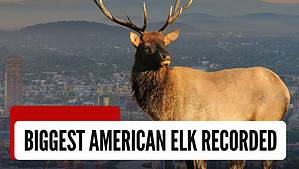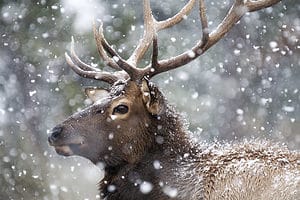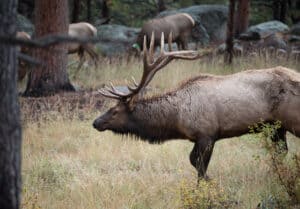Have you ever encountered an elk while driving through dense forests or hilly areas? How would you react upon spotting them on the roadside, in parking areas, or even in your backyard? Do you experience fear that they might pose a threat or become aggressive? Have you had the opportunity to approach or get close to them? Where do you believe these creatures can be found in the state of Oklahoma? Are you interested in learning about the largest elk ever captured in Oklahoma’s history and who captured it?
Let’s explore all of these questions and more as we delve further into this article.
Insights Into the Elk Kingdom
Elk, the second-largest deer family, is known as “bull” for adult males and “cow” for adult females. They belong to the Cervidae family, which also includes caribou, deer, and moose. They are classic red deer in their biology. Elk have long legs, massive antlers, and two-toed or cloven hooves compared to their family counterparts like moose. They are broader than deer but not as massive as moose.
North America boasts the largest elk population, residing in the USA and Canada. These countries harbor various species, including Rocky Mountain Elk, Roosevelt Elk, Manitoban Elk, and Tule Elk. The combined population of these four elk species is estimated to range from 1 to 1.2 million.
Research indicates that in North America, Colorado hosts the largest elk population, surpassing 280,000 animals. A significant portion of elk herds in Colorado is either at or close to target levels.
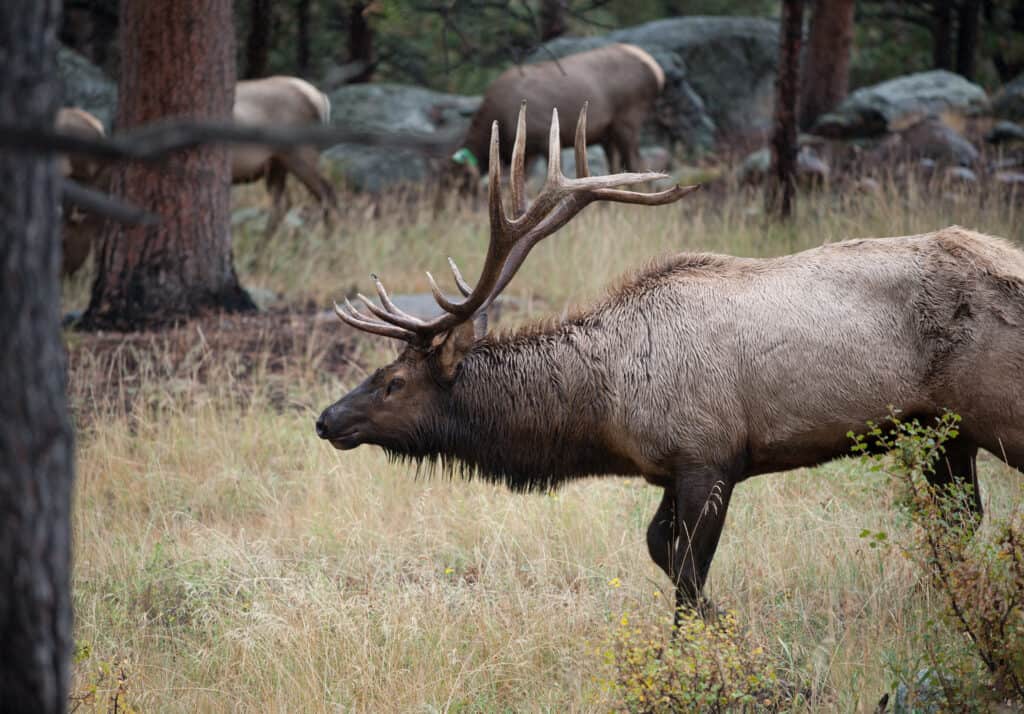
A large North American elk is standing in an open meadow.
©Tony Campbell/Shutterstock.com
Etymology of Elk
The term elk originates from the ancient Germanic term for stag or hart. English settlers in the 16th century referred to the native subspecies of the red deer as elk. Although the word wapiti was used for these red deer subspecies, it didn’t gain popularity, firmly establishing elk as the proper name.
The term wapiti originates from the Native American languages of the Shawnee and Cree tribes. It evolved from the form waapiti. The word wap refers to the distinctive light fur and white rump of the animal. The wapiti’s coat can change, transitioning from reddish-brown in summer to dark brown in winter, and it may also display additional colors like dirty blonde, beige, or even lemony white. While it may appear white from a distance, the rump reveals hues from ivory to orange upon closer examination. In contrast, the head and neck exhibit dark coloring. The wapiti boasts a mane of long black hair around its neck.
Antlers
Male elk, or bulls, possess antlers, while female elk lack them. Bull antlers can reach heights of up to 4 feet or 1.2 meters above their heads, giving them a tall appearance. These antlers play a vital role in mate selection, with cows choosing bulls with larger antlers during mating season.
Unlike bison horns, male elk shed their antlers every year in spring, and a new set of antlers grows in preparation for the mating season. When the male elk sheds its antlers, the velvet covering them during the growth phase protects the antlers and carries blood to the growing bone tissue.
The shedding period for bull elk generally falls between January and March. However, it depends on various factors such as testosterone levels, age, body condition, and the length of daylight, known as photoperiod. Older bulls typically shed their antlers earlier than younger males.
During the summer months, antlers can grow up to one inch per day, reaching their full size, and each antler can weigh up to 40 pounds. This makes them the fastest-growing bone known. Female elk usually select a dominant bull with larger antlers during the mating season. The mating season primarily occurs in the months of September and October and may sometimes extend up to November.
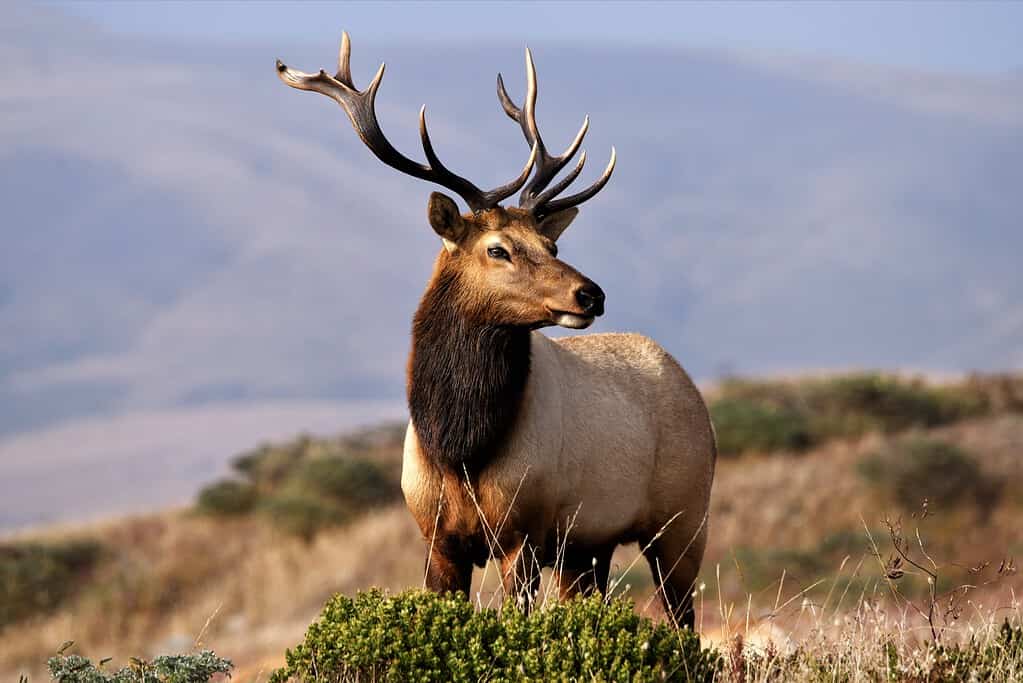
A majestic elk herd leader stands atop a grassy hill.
©iStock.com/Eric Clark
Weight
Bulls typically weigh between 700 and 1100 pounds, while females generally weigh between 500 and 600 pounds.
Height
Male elk are typically 5 feet tall at the shoulders. Female elk generally are 4.5 feet tall at the shoulder. Female Elk are smaller in size compared to Male elk.
Habitat
Elk can thrive in diverse habitats, including mountains, forests, and meadows. North American elk flourished until European settlers arrived in the region. Researchers estimate the elk population reached around 10 million before the arrival of European settlers. These settlers hunted elk for sustenance and due to concerns about potential competition with their livestock. Furthermore, the market’s demand for elk products, including ivory, fur, and antlers, contributes to the elk harvest.
Extensive land clearing for farms and urban development led to the loss of elk habitat. Consequently, due to over-harvesting and habitat destruction, elk populations dwindled, hitting a low of 90,000 by 1900. By the 20th century, two of the six subspecies, including the Eastern elk that inhabited the eastern United States, had gone extinct. Fortunately, concerned Americans advocated for regulated hunting seasons and launched elk recovery programs.

Research indicates that in North America, Colorado hosts the largest elk population, surpassing 280,000 animals.
©welcomia/iStock via Getty Images
Food
Elk, classified as grazers, possess a four-chambered stomach, enabling them to consume a variety of foods. Their diet includes grass, forbs, mast, low-growing plants, berries, tender shoots, lichens, bark, and evergreen needles, depending on seasonal availability.
Elk occasionally damage crops and fences, but elk management areas usually lack extensive agricultural land. According to experts, an elk can consume vegetation or landscaping worth $10,000 in a single night.
Elk’s teeth resemble those of deer, with the unique addition of upper canine teeth made of ivory. Both Native Americans and European settlers highly valued these teeth. An elk’s molars and incisors are reliable indicators of its age.
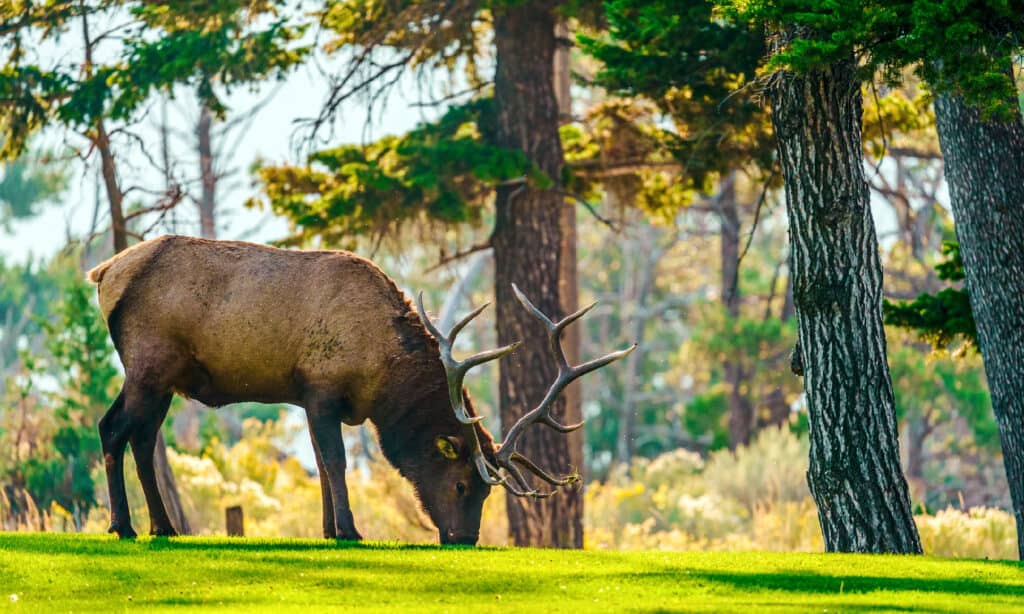
Adult male elk with huge antlers eating green grass in the shade.
©iStock.com/FluidMediaFactory
Mating
In contrast to deer, the Elk family experiences a rut, or mating season, during autumn. Male elk gather harems of females and guard them from competing males. This selective breeding process happens from September through October, sometimes extending into November.
Female elk have a gestation period of roughly 8.5 months, giving birth from late May to early July. During calving, cows separate from the herd and conceal their calves, keeping them hidden for their first few months. Calves are only exposed to the outer world once they’re capable of running from predators. Typically, cows give birth to a single calf, although twins are rare. Newborn calves weigh around 35 pounds.
To protect themselves from predators, elk form herds. While cows and calves live in herds or groups, they are generally joined by bulls only during the mating season. Cows typically display social behaviors. They guide the herd to water and feeding areas. The leading cow is usually a mature one and has memorized essential trails to and from their home range.
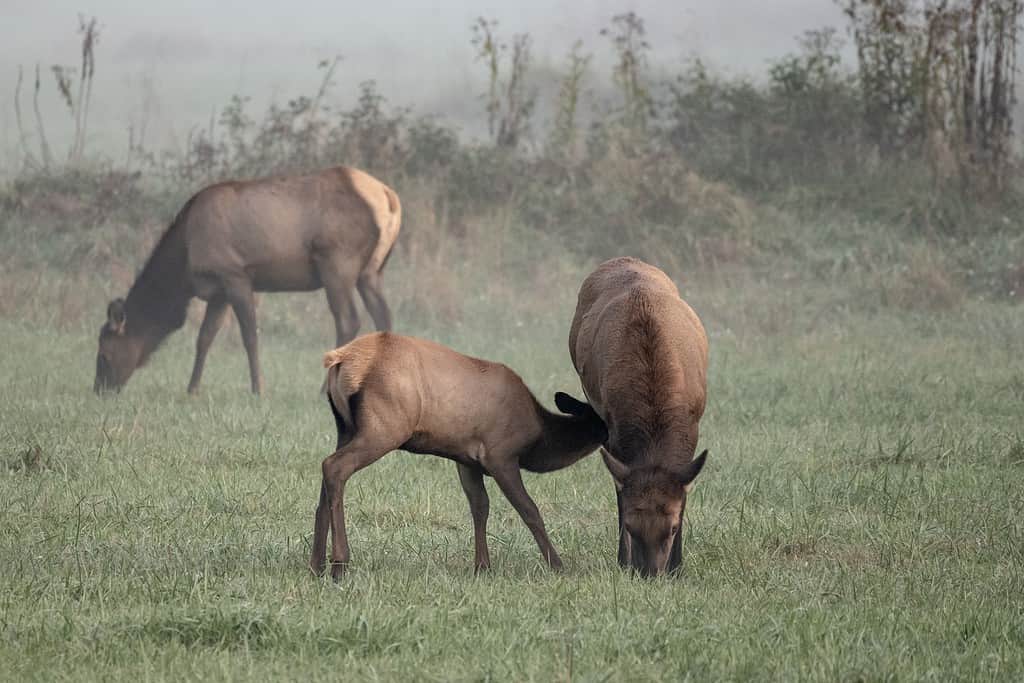
During calving, cows separate from the herd and conceal their calves, keeping them hidden for their first few months.
©Kelly vanDellen/Shutterstock.com
Oklahoma’s Elk Population
Before we explore the elk population in Oklahoma, let’s gain some insight into Oklahoma’s neighboring states. Oklahoma shares its borders with six states: Colorado to the northwest, Kansas to the north, Missouri to the northeast, Arkansas to the east, Texas to the south, and New Mexico to the west. Oklahoma’s Panhandle touches a small portion of Colorado and New Mexico.
- According to research, Colorado boasts the largest elk population in North America, with over 280,000 animals. Most herds in Colorado are either at or near target levels.
- The Kansas Department of Wildlife and Parks reports that elk were common in pre-settlement Kansas but were extirpated at the turn of the century.
- The Missouri Department of Conservation notes a rising elk population, with a significant increase in elk numbers.
- As per the Arkansas Game and Fish Commission, there are around 419 elk, which is about a 5 percent increase from last year.
- Experts believe 1,500 to 2,000 elk live in the free range of west Texas as of 2023.
- As per the New Mexico Department of Game and Fish, between 72,000 and 102,000 elk live throughout the state.
Oklahoma is surrounded by elk-populated states, indicating potential migration from neighboring states. According to the Oklahoma Department of Wildlife Conservation, recent unofficial records show around 5,000 elk populations.

Recent unofficial records show around 5,000 elk populations in Oklahoma.
©MorphoBio/Shutterstock.com
The First Biggest Elk Ever Harvested in Oklahoma
According to Oklahoma State Big Game Records, Olivia A. Parry of Camargo holds the first spot for typical elk in Oklahoma’s Cy Curtis Awards Program, having harvested the largest-ever American Elk in Oklahoma in 2016. The record holds good as of 2023, but it’s subject to change if someone sets a new record.
Category: Typical Elk
Hunter(s): Olivia A. Parry
Owner(s): Olivia A. Parry
Location: Dewey County, OK, USA
Date: 10/16/2016
Elk Size: 377 6/8
Elk Sex: Bull
For additional information, please access the details on their website, which requires an account for data viewing.
The Second Biggest Elk Harvested in Oklahoma
According to the Oklahoma Department of Wildlife Conservation, Johnathan Moore of Guymon now holds the top second spot for nontypical elk in Oklahoma’s Cy Curtis Awards Program. Moore’s archery harvest now holds the title of the new non-typical Cy Curtis state record, with his bull scoring 371 6/8.
Category: Nontypical Elk
Hunter(s): Johnathan Moore
Owner(s): Johnathan Moore
Location: Texas County, OK, USA
Date: 10/1/2017
Elk Size: 371 6/8
Elk Sex: Bull
For additional information, please access the details on their website, which requires an account for data viewing.
The Third Biggest Elk Harvested in Oklahoma
According to the Oklahoma Department of Wildlife Conservation, Lonnie Pierce of Guymon now holds the top second spot for nontypical elk in Oklahoma’s Cy Curtis Awards Program. Pierce’s bull scored 355 6/8 and is the largest ever harvested with a muzzleloader and the second-largest nontypical elk in the state record book.
Category: Nontypical Elk
Hunter(s): Lonnie Pierce
Owner(s): Lonnie Pierce
Location: Texas County, OK, USA
Date: 11/1/2017
Elk Size: 355 6/8
Elk Sex: Bull
For additional information, please access the details on their website, which requires an account for data viewing.
About Cy Curtis Awards Program
The Cy Curtis Award program was initiated to honor the renowned former wildlife department biologist Cy Curtis. He dedicated his life to the restoration of white-tailed deer in Oklahoma. These awards were founded in 1972 and have expanded to recognize various trophy animals, including elk, black bears, mule deer, and antelopes. Hunters who harvest these trophy animals receive this award.
Hunting Elk in Oklahoma
To hunt in Oklahoma, obtain a Resident Elk license and Resident Hunting License for $51, valid from January 01 to December 31. These licenses can be acquired from licensed dealers, such as bait shops or sporting goods stores. For more information, click here.
The 2023 elk hunting seasons are as follows:
- Elk Archery: October 1, 2023, to January 15, 2024 (open zones only).
- Youth Elk Gun: October 20, 2023, to October 22, 2023 (open zones only).
- Elk Muzzleloader: October 28, 2023, to November 5, 2023 (open zones only).
- Elk Gun: November 18, 2023, to December 3, 2023 (open zones only).
- Holiday Antlerless Elk Gun: December 18, 2023, to December 31, 2023 (open zones only).
Ensure zone limits haven’t been reached by visiting wildlifedepartment.com. For details on all Elk Open Zones, visit the provided link. Resident landowners or tenants who hunt exclusively on their owned or agriculturally leased land are exempt from the hunting license requirement.
Where to Spot Elk in Oklahoma
The largest free-ranging elk herds in Oklahoma can be found at the Wichita Mountains Wildlife Refuge. You can also spot elk herds at Pushmataha, Cooking Hills, Cherokee wildlife management areas, and Spavinaw. Smaller herds are occasionally seen on private lands in Caddo, Kiowa, and Comanche Counties.
Reports suggest that the Oklahoma Department of Wildlife Conservation (ODWC) is considering relocating elk to their historic range in the Arbuckle Mountains, situated 80 miles south of Oklahoma City.
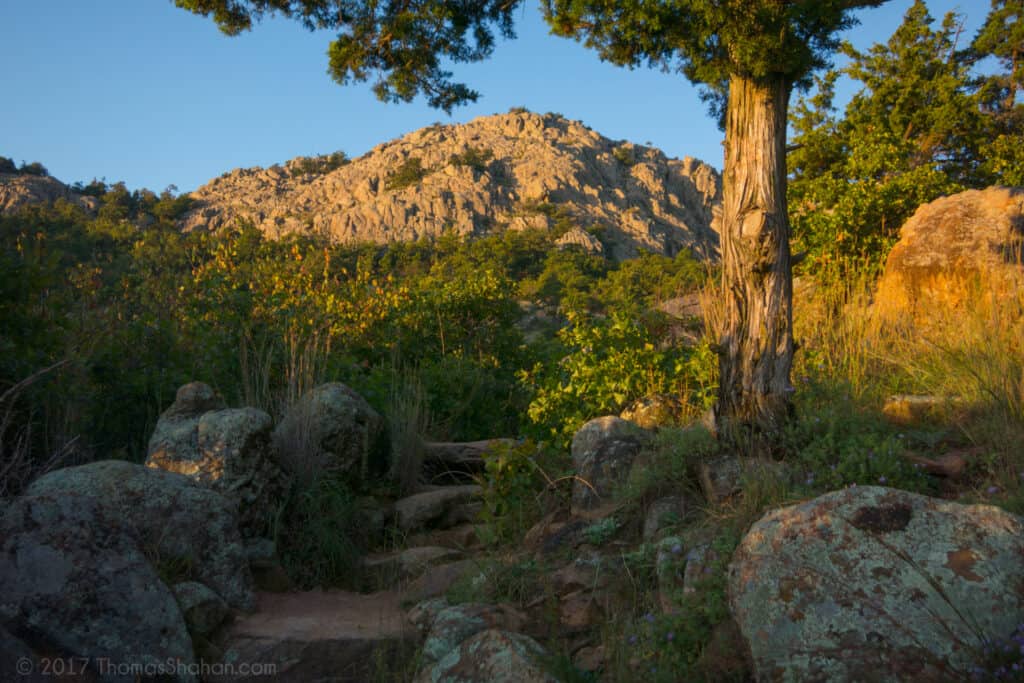
Elk Mountain within the Wichita Mountains, Oklahoma.
©Thomas Shahan / flickr – License
Conclusion
Hunting elk demands skill, patience, preparation, and a deep respect for animals and the environment. It’s integral to wildlife conservation and management.
Once a hunter has located an elk, they need to make a clean, humane shot. Since they are large animals, they can be difficult to kill with a poorly placed shot. Hunters should also be prepared to track a wounded elk if necessary. Elk hunting is physically demanding, and it requires hunters to be in good shape. Hunters should also be prepared for all types of weather conditions.
On the other hand, elk hunting can also have negative impacts on the environment and on the animals. Elk are sentient beings that experience pain and suffering. Hunting can also disturb other animals and damage habitats. Additionally, some people argue that elk hunting is unethical and there are other ways to manage elk population without killing them. According to experts and scientists, various animals, including mountain lions and black bears, may rely on elk for food. If the elk population were to disappear, it could have severe consequences for some of these dependent animals and for the environment.
The Top 20 Cy Curtis Award Program Winners Based on the Size of the Harvested Animals.
1 to 10
| Rank | Category | County | Season | Hunter Name | Home Town | Points Left | Points Right | Final Score | Harvest Date |
| 1 | Typical Elk | DEWEY | Gun | OLIVIA PARRY | CAMARGO | 6 | 6 | 377 6/8 | 10/16/2016 |
| 2 | Non-Typical Elk | TEXAS | Archery | JOHNATHAN MOORE | GUYMON | 7 | 7 | 371 6/8 | 10/1/2017 |
| 3 | Nontypical Elk | TEXAS | Muzzleloader | LONNIE PIERCE | GUYMON | 7 | 7 | 355 6/8 | 11/1/2017 |
| 4 | Nontypical Elk | DEWEY | Archery | TYSON HIEBERT | SEILING | 9 | 9 | 346 7/8 | 10/3/2017 |
| 5 | Typical Elk | CIMARRON | Gun | BOB HAMLIN | OKMULGEE | 6 | 7 | 338 4/8 | 12/17/1994 |
| 6 | Typical Elk | COMANCHE | Gun | WAYNE MUNN | RUSH SPRINGS | 6 | 7 | 332 1/8 | 12/11/2014 |
| 7 | Nontypical Elk | MUSKOGEE | Gun | Jeremy Parker | 7 | 11 | 330 4/8 | 11/21/2018 | |
| 8 | Typical Elk | CADDO | Archery | HUDSON HERRING | LAWTON | 6 | 6 | 329 8/8 | 10/2/2021 |
| 9 | Nontypical Elk | COMANCHE | Gun | JERRY JAYNES | MUSKOGEE | 8 | 9 | 325 7/8 | 12/15/2005 |
| 10 | Nontypical Elk | DEWEY | Archery | EDWARD PARRY | CAMARGO | 8 | 6 | 320 6/8 | 10/3/2017 |
11 to 20
| Rank | Category | County | Season | Hunter Name | Home Town | Points Left | Points Right | Final Score | Harvest Date |
| 11 | Typical Elk | COMANCHE | Gun | JOE KYSELA | OKLAHOMA CITY | 7 | 6 | 310 1/8 | 10/7/2000 |
| 12 | Typical Elk | COMANCHE | Gun | GARY BEARDSLEE | EL RENO | 6 | 7 | 308 4/8 | 1/11/2018 |
| 13 | Typical Elk | KIOWA | Gun | MARK THOMPSON | SHAWNEE | 6 | 6 | 307 6/8 | 12/2/2013 |
| 14 | Typical Elk | COMANCHE | Gun | MIKE CHAIN | OKLAHOMA CITY | 7 | 7 | 305 5/8 | 1/1/2016 |
| 15 | Typical Elk | COMANCHE | Muzzleloader | SHELBY ADCOCK | NORMAN | 6 | 6 | 302 1/8 | 10/7/2021 |
| 16 | Typical Elk | CHEROKEE | Gun | DONNIE ANDERSON | BROKEN ARROW, OK | 8 | 6 | 301 4/8 | 10/3/2002 |
| 17 | Typical Elk | COMANCHE | Gun | JEFF RETHERFORD | NEWCASTLE, OK | 6 | 7 | 298 1/8 | 12/3/2000 |
| 18 | Typical Elk | COMANCHE | Gun | STEVE ST. CYR | MOORE | 6 | 6 | 297 5/8 | 12/11/2014 |
| 19 | Typical Elk | COMANCHE | Archery | KEVIN EZELL | LAWTON | 6 | 6 | 296 7/8 | 10/5/2015 |
| 20 | Typical Elk | COMANCHE | Gun | ERNEST MCDANIEL | CLAREMORE | 6 | 7 | 295 3/8 | 1/10/2017 |
The photo featured at the top of this post is © iStock.com/Eric Clark
Thank you for reading! Have some feedback for us? Contact the AZ Animals editorial team.



